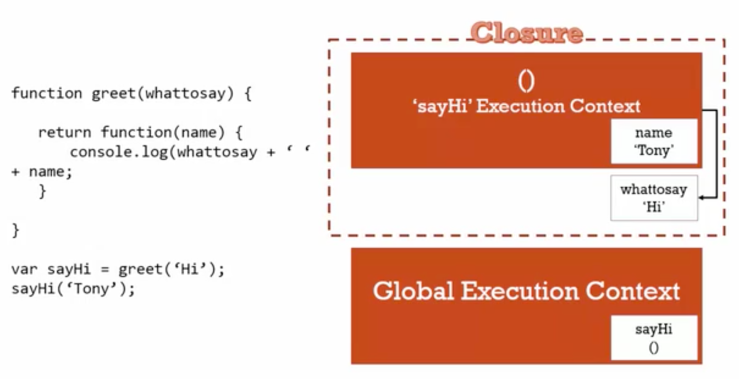Closure is a feature of JS. It enables a function to have access to the variables of it’s outer parent method although that method executed and gone from the execution context. It doesn’t matter when we invoke the function, JS will ensure that the method will have access to the variable it’s suppose to have access to, that it’s scope is intact.
A closure is an inner function that has access to the variables in the outer (enclosing) function’s scope chain. The closure has access to variables in three scopes; specifically: (1) variable in its own scope, (2) variables in the enclosing function’s scope, and (3) global variables.

Closure de-mistified – udemy video
What is a Closure? link
A closure is the combination of a function bundled together (enclosed) with references to its surrounding state (the lexical environment). In other words, a closure gives you access to an outer function’s scope from an inner function. In JavaScript, closures are created every time a function is created, at function creation time.
To use a closure, simply define a function inside another function and expose it. To expose a function, return it or pass it to another function.
The inner function will have access to the variables in the outer function scope, even after the outer function has returned. Closures are capable of not only reading, but also manipulating the variables of their outer functions.
Using Closures (Examples)
Among other things, closures are commonly used to give objects data privacy. Data privacy is an essential property that helps us program to an interface, not an implementation. This is an important concept that helps us build more robust software because implementation details are more likely to change in breaking ways than interface contracts.
In JavaScript, closures are the primary mechanism used to enable data privacy. When you use closures for data privacy, the enclosed variables are only in scope within the containing (outer) function. You can’t get at the data from an outside scope except through the object’s privileged methods. In JavaScript, any exposed method defined within the closure scope is privileged.
Objects are not the only way to produce data privacy. Closures can also be used to create stateful functions whose return values may be influenced by their internal state.
What is a closure? link
At first glance, a closure is simply a function defined within another function. However, the power of closures is derived from the fact that the inner function remembers the environment in which it was created. In other words, the inner function has access to the outer function’s variables and parameters.
Function factories
One powerful use of closures is to use the outer function as a factory for creating functions that are somehow related.
function dwightJob(title) {
return function(prefix) {
return prefix + ' ' + title;
};
}
var sales = dwightJob('Salesman');
var manager = dwightJob('Manager');
alert(sales('Top')); // Top Salesman
alert(manager('Assistant to the Regional')); // Assistant to the Regional Manager
alert(manager('Regional')); // Regional Manager
***** Namespacing private functions
Many object-oriented languages provide the ability to declare methods as either public or private. JavaScript doesn’t have this functionality built in, but it does allow to emulate this functionality through the use of closures, which is known as the module pattern.
var dwightSalary = (function() {
var salary = 60000;
function changeBy(amount) {
salary += amount;
}
return {
raise: function() {
changeBy(5000);
},
lower: function() {
changeBy(-5000);
},
currentAmount: function() {
return salary;
}
};
})();
alert(dwightSalary.currentAmount()); // $60,000
dwightSalary.raise();
alert(dwightSalary.currentAmount()); // $65,000
dwightSalary.lower();
dwightSalary.lower();
alert(dwightSalary.currentAmount()); // $55,000
dwightSalary.changeBy(10000) // TypeError: undefined is not a function